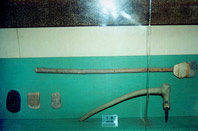| Legole.Com Discover china. Explore the beauty and wonder of the land, people, and culture of China. |
 |
|
|
 |
| |
 the Yangshao Culture of the Neolithic Age(about 10,000 B.C. to 5,000 B.C.), which originated in the middle valley of the Yellow River. As this culture was discovered in the vicinity of today's Banpo Village, in Xian City in the Shaanxi Province, it was named after this village. However, thousands of years ago it was not so called. Primitive Banpo villagers lived 6,800-6,300 years ago, and they came from two different tribes. In light of many kinds of farm implements and fishing tools excavated, it is inferred that the Banpo people depended primarily on farming and fishing for survival. At the same time, the Banpo people cultivated a colored Pottery Culture, one of the most representatives of Yangshao Culture. Their earthen wares were uniformly red in colour and decorated with black pigment. The craftsmen had their potteries simply decorated, the most striking are the designs of fish that can be seen everywhere. The fish was finished in symbolic pattern.. It is concluded that fish should be the totem of ancient Banpo people. Here the masterpiece wares include: a tip-bottomed bottle, which is a water sucker under the principal of shifting gravity center (not really clear); and a painted basin with design of a human face holding fish at the corners of mouth. Moreover, on certain similar parts of potteries are found twenty-two kinds of mysterious marks, which are estimated to be some primitive script. the Yangshao Culture of the Neolithic Age(about 10,000 B.C. to 5,000 B.C.), which originated in the middle valley of the Yellow River. As this culture was discovered in the vicinity of today's Banpo Village, in Xian City in the Shaanxi Province, it was named after this village. However, thousands of years ago it was not so called. Primitive Banpo villagers lived 6,800-6,300 years ago, and they came from two different tribes. In light of many kinds of farm implements and fishing tools excavated, it is inferred that the Banpo people depended primarily on farming and fishing for survival. At the same time, the Banpo people cultivated a colored Pottery Culture, one of the most representatives of Yangshao Culture. Their earthen wares were uniformly red in colour and decorated with black pigment. The craftsmen had their potteries simply decorated, the most striking are the designs of fish that can be seen everywhere. The fish was finished in symbolic pattern.. It is concluded that fish should be the totem of ancient Banpo people. Here the masterpiece wares include: a tip-bottomed bottle, which is a water sucker under the principal of shifting gravity center (not really clear); and a painted basin with design of a human face holding fish at the corners of mouth. Moreover, on certain similar parts of potteries are found twenty-two kinds of mysterious marks, which are estimated to be some primitive script.
Meanwhile Banpo Culture witnessed the time of matriarchal clan society. Women took a dominant position in everything and there were no permanent couples. After death, adult women and men were buried separately in communal graveyard, having potteries and beads of animal bones as burial objects. Children, however, were not allowed be buried with adults. The mother would put the body of her child into pottery jar and bury it in a pit close to her house. This special burial jar practice reveals that child was still not counted as the member of primitive community. More burial articles were found in girl's pit than in that of boys.
|
|
|
 |
|
